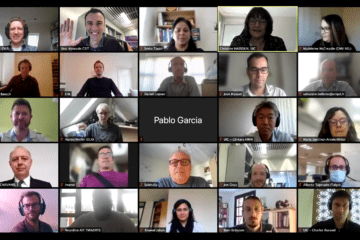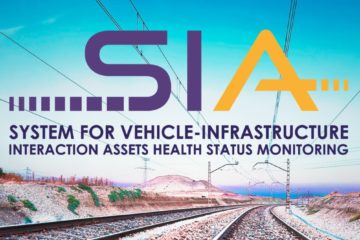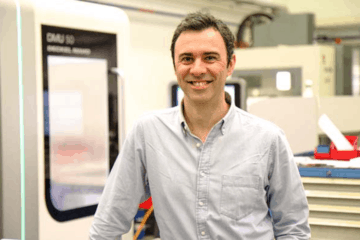EUSPA-funded SIA project is nearing its completion with promising results for intelligent railway asset management
SIA has as main objective the development of four ready-to-use new services (iWheelMon, iRailMon, iPantMon and iCatMon) providing prognostic information on the health status of the railway’s most demanding assets in terms of maintenance costs.
Space based services will help reduce 15% of railway maintenance costs, 25% of maintenance unscheduled events and 15% of derailments associated with the rail-wheel interface. To tackle this challenge, the SIA consortium brings together multidisciplinary and cross sector partners (EGNSS technology providers, research centres, IT companies and railway stakeholders) that will co-design EGNSS solutions truly adapted to the needs of the rail sector.
Railway infrastructure and vehicle maintenance are estimated to cost over 25 billion Euros per year in Europe, and this figure is rising(1) . The distribution of maintenance expenses varies in different countries and organizations. However, in relation to the railway infrastructure, track expenses represent between 40%-70% of the operational expenses, where the defects associated with the rails and catenary are the most significant (30% and 50% respectively). Other major maintenance costs relate to vehicle equipment such as the wheelset and pantograph (typically between 30%-50% and 5%-10% of the overall vehicle’s maintenance cost respectively). These figures are similar for all the infrastructure managers (IMs) and train operating companies (TOCs), which in total accounts for 330 organizations in the EU and 1500 organisations worldwide, therefore incurring over 8 billion Euros in recurrent expenses in the EU.
SIA project (System for vehicle-infrastructure Interaction Assets health status monitoring) has been funded by EUSPA since 2018 with the objective of developing four ready-to-use new services, to provide prognostic information about the health status of railways’ most demanding assets in terms of maintenance costs, at the points of the interaction between the vehicle and the infrastructure (wheelset, pantograph, rail, and catenary).
iCatMon is a service oriented towards IMs and maintenance subcontractors. The service provides information about the status of the overhead line (e.g. geometry of the Overhead Contact Wire – OCW).
iPantMon is intended for TOCs, providing information about the status of the pantograph during its interaction with the OCW (e.g. contact dynamics).
iWheelMon is also intended for TOCs, this service provides information about the health status of the wheelset (e.g. wheel diameter, out-of-roundness).
iRailMon is a service oriented towards IMs and maintenance subcontractors, the service provides information about defects on the rails (e.g. short-wave irregularities).
To enable these services, a modular system with all of the required components from vehicle sensor networks to KPI visualization for the end user has been developed. The value proposition of SIA is to develop these components in the most cost-effective way, i.e. with the use of cost-effective sensors and systems.
The SIA components include a sub-system for the recording of axle-box acceleration (ABA) data that can be related to defects in the track and wheelset. Another sub-system includes sensors that provide signals to characterize the interaction between the pantograph and catenary. EGNSS- based localization is performed, with real time processing of GNSS signals in multiple frequency bands including Galileo and map-supported refinement using Kalman filter methods in the back-office. A central datahub provides the onboard data management and communicates with the back-office part of SIA, for instance, to send events or detections in the monitoring data. The axle-box acceleration and pantograph data enriched with position information are further processed using component degradation models and analysis algorithms in the back-office. Finally, relevant asset key performance indicators (KPI) are displayed to the user in the visualization platform, with a rich functionality to illustrate the asset status and its evolution using different capabilities.
To validate the results, pilot tests have been carried out since October 2020 in three different scenarios: one of them coordinated by OBB (Österreichische Bundesbahnen), the Austrian operator, using both inspection vehicles and regular in-service trains throughout Austrian rail network; another scenario coordinated by VIAS, a Spanish maintenance subcontractor, using for the installation of the system a maintenance vehicle circulating over Madrid-Córdoba high-speed line; and the third scenario was coordinated by FGC (Ferrocarrils de la Generalitat de Catalunya), a Spanish regional TOC, using regular in-service trains throughout its whole network.
The results obtained so far are very promising. The aim is to validate the use of low-cost on-board systems to assess the health status of infrastructure and vehicle assets using the four developed services. Part of this success is due to the use of digital twins and AI technologies to extract health related KPIs. Some of the activities within the project contributed to the creation of a tech startup (MainRail Solutions), dedicated to the management of railway infrastructure. This start-up, created by Ceit and Inycom (linked third party of INGECONTROL) in 2020, has initiated its activities by deploying its first commercial references, e.g. tranvía Zaragoza (Spain) and SFM (Mallorca Railways, Spain) and PoC (Proof of Concept) pilots with other TOCs and IMs in Spain.
The implementation of the SIA system in regular service trains will enable a reduction in the costs associated with maintenance, while keeping the required levels of safety and service availability. The low-cost nature of the on-board equipment and the capabilities brought by the new services can potentially lead to reductions of 10% in the cost of the maintenance associated to the infrastructure’s assets, thanks to a reduction of unscheduled actions and MTTR (Mean Time To React).
This project has received funding from the EU H2020 R&I programme and from the European Union Agency for the Space Programme under grant agreement #776402.
This article was first published in the European Union Agency for the Space Programme (EUSPA) newsletter.
(1) Using analytics to get European rail maintenance on track, McKinsey & Company, 2020


